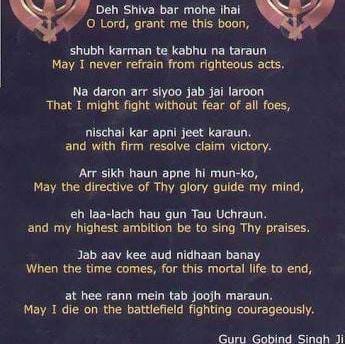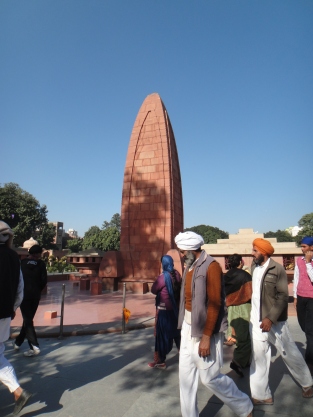The Archbishop of Canterbury visited Jallianwala Bagh earlier this week and expressed shame and sorrow for what happened there in 1919, exactly a hundred years ago. He came to India with a wish to make things better in the contentious world of Religion and, for that reason, met with leaders of other religions in India in his capacity as a spiritual leader.
Yesterday’s issue of The Times of India carried an editorial by Michael Binyon, the editorial writer for the The Times, London, about the Archbishop’s visit. One of the things he said is that the Archbishop ‘did not achieve any dramatic breakthrough in his meetings with Hindu, Muslim, Sikh and leaders of other Christian denominations in India’, which is rather sad. I hope that was only initial awkwardness, and that this initiative will be taken forward by all involved, though I can’t help wondering what exactly are the sticking points that these leaders cannot agree on.

In the last paragraph of the above article the Archbishop says, “One of the most profound, deep, philosophical civilisations, India has received into its life the many faiths that thrive in this country. India’s culture and history – except when manipulated – has been one of learning to value that diversity and this is so important.”
“Value that diversity”:
Now, this is true of all countries, not India alone. Every country is diverse because countries with tightly guarded borders are a fairly new phenomenon. India has been a country for only seventy-two years. Before that it was just a vast campsite for a whole lot of unrelated people who came from everywhere and stayed on in ethnic clusters that grew into towns, cities, principalities and kingdoms.
People teach themselves to value diversity when they have no choice and a tribal mentality proves counterproductive. It’s not really natural. The other option is to Brexit themselves out of the diversity I guess. In equivalent terms, governments in many modern-day countries accept legal immigrants and refugees, and their populations become diverse, sometimes to the dismay of citizens.
“Except when manipulated”:
Manipulation is exactly what has been going on for thousands of years all over the world! No country has escaped it. It’s a human trait that gets more pronounced when a mob or an exploitative bully are in control. Ever since the woman carrying the L3 mitochondrial-DNA walked out of Africa with the man with the Y-chromosome CT and started populating the rest of the world 70,000 years ago, that’s all that’s been happening!
Manipulating others, like overpowering the Neanderthals to make space for Homo sapiens, manipulating the environment, like destroying forests to make space for agriculture, driving entire animal species to extinction, torturing and killing conquered peoples, banning their cultural mores, imposing language, i.e. communication, restrictions on them, plundering resources by evicting, enslaving or killing the rightful inhabitants – this is the bad side of the history of us human beings, isn’t it (the good one being co-operation and progress as a species)?
And Jair Bolsonaro now says the fires raging in the Amazon rainforest are ultimately good for Brazil’s economy so don’t try too hard to put them out! Manipulation – everywhere, all the time, by anyone with a little bit of power – is the norm! Manipulation is finessed nowadays because there are college courses on how to manage everything and everyone, and networking is a thing, so people think they aren’t being obvious.
********************************
Like the Archbishop of Canterbury, there are others handling religious strife in their own way. Here’s a picture of a Catholic Bishop apparently trying to make it easier for Hindus to relate to Christianity. The Catholic Bishop is dressed up like a Hindu Swamiji: saffron robe, kumkum tikka on forehead, rudraksha mala around his neck. Behind him is one more person dressed the same way. As explained by the Archbishop of Goa, this is what the Catholic Church calls inculturation.
 Hindus criticise this as cultural appropriation. As there are thousands of Christians in India, and people are quite familiar with Christianity, it was not necessary for the Bishop to adopt the inductive teaching method of going from the known to the unknown, if that was his intention. That’s why it came off as a parody of both Hinduism and Christianity, especially when it was reported that the tabernacle was shaped like a shivalinga! This much fusion simply cannot work when it’s a question of faith and tradition and what people hold sacred. A Christian bride will not get married in a black gown or a red sari, and a Hindu bride will not wear a white sari for her saath pheras around the sacred fire. Some things have a value and meaning beyond the practical and utilitarian, and I don’t think anybody has the right to violate them.
Hindus criticise this as cultural appropriation. As there are thousands of Christians in India, and people are quite familiar with Christianity, it was not necessary for the Bishop to adopt the inductive teaching method of going from the known to the unknown, if that was his intention. That’s why it came off as a parody of both Hinduism and Christianity, especially when it was reported that the tabernacle was shaped like a shivalinga! This much fusion simply cannot work when it’s a question of faith and tradition and what people hold sacred. A Christian bride will not get married in a black gown or a red sari, and a Hindu bride will not wear a white sari for her saath pheras around the sacred fire. Some things have a value and meaning beyond the practical and utilitarian, and I don’t think anybody has the right to violate them.
While I agree with the Archbishop of Canterbury’s observation that India values her diversity I honestly think we paid a huge price for it. What looks like diversity in the present era of relative peace is the result of the terror, physical pain and loss of loved ones that our forefathers went through when they were raped, tortured and massacred by marauders over hundreds of years, when there were no borders, and no standing army. We all shook down together and made ourselves a country just a few decades ago.
Going back to what the Archbishop said, yes, we have been manipulated a lot over the centuries by all and sundry, but the resilient land that is India has survived the onslaught of an endless stream of invaders only because syncretism and adaptation are more natural to us than rigid beliefs that won’t budge to adapt. While we are aware that others have taken advantage of this quality in us for their ends, we can’t change that without losing a valuable part of ourselves. So we stand like coconut trees, we bend but don’t break in a storm, and hope the damage is rectifiable when the storm is over.








